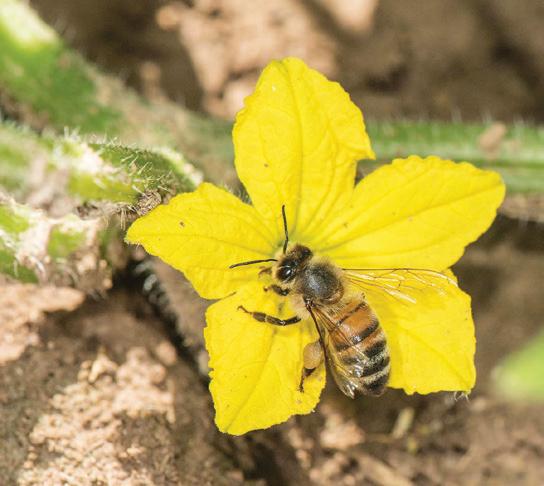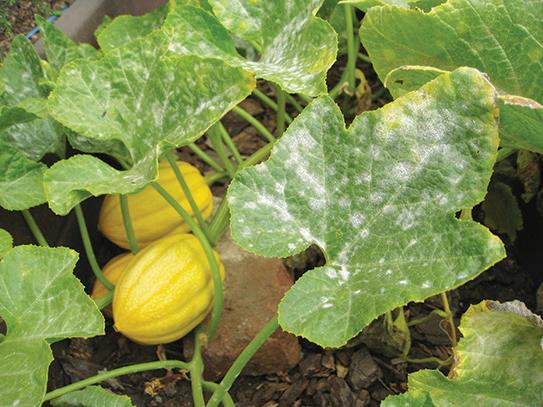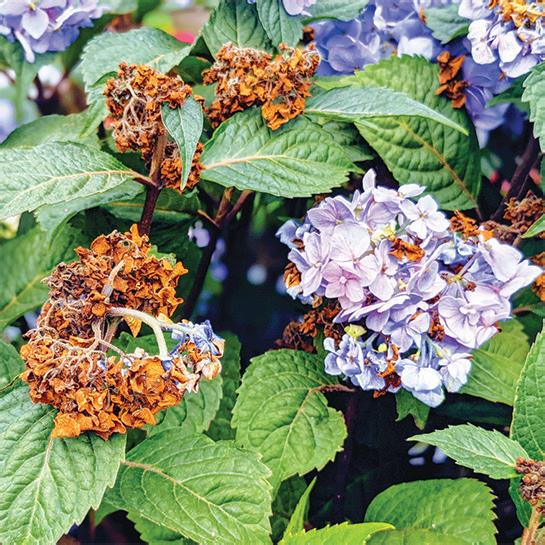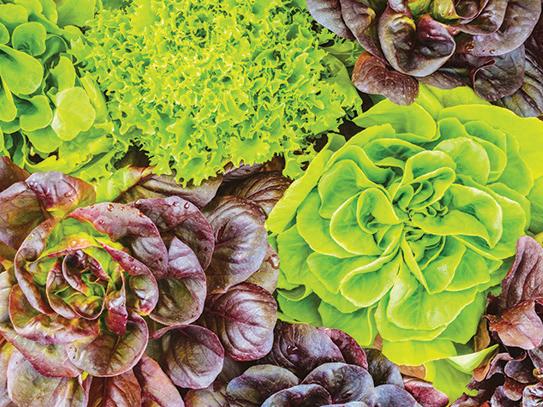
9 minute read
Tidewater Gardening: K. Marc Teff eau
Dorchester Map and History


© John Norton
Dorchester County is known as the Heart of the Chesapeake. It is rich in Chesapeake Bay history, folklore and tradition. With 1,700 miles of shoreline (more than any other Maryland county), marshlands, working boats, quaint waterfront towns and villages among fertile farm fi elds – much still exists of what is the authentic Eastern Shore landscape and traditional way of life along the Chesapeake.
For more information about Dorchester County visit https://tidewatertimes.com/travel-tourism/dorchester/.
TIDEWATER GARDENING
by K. Marc Teffeau, Ph.D.

End of Fruit Month
The Indigenous tribes of North America had names for the different months of the year. The Cherokee called August the “End of Fruit Month.” The Cherokee calendar was based on a lunar calendar marked by 13 moon cycles of 28 days each. My step-grandmother, “Nona,” who raised my father, was a Cherokee from Flowery Branch, Georgia. I remember my Nona planting her vegetable garden by the cycles of the moon.
Whether we call August the End of Fruit Month; Hot, Humid and He** Month or whatever, this month’s heat and humidity can be brutal. When temperatures get and consistently stay above 85⁰ F during the day and above 70⁰ F at


night, gardeners tend to notice a drop-off of production in the vegetable garden. Tomato, pepper and eggplant flowers will not pollinate when temperatures are above 90⁰ F. The flowers will form but will then die and fall off the plant before becoming fruit.
At these warm temperatures, the tomato plant is stressed and burns up energy reserves. The heat stress modifies the flowers, making them harder to pollinate. As a result, the blossom often drops off without pollination occurring. You will also notice leaf rolling on tomato plants. The same effect on flower formation and pollination occurs with green beans. The flowers will abort in hot tempera-

Rt. 50 at Rt. 565, 2 mi. South of Easton
410-822-8866 www.riodelmarent.com

SALES - PARTS - SERVICE
RIO DEL MAR ENTERPRISES

LOOK FOR US IN OUR NEW LOCATION!
The former Salisbury Pewter building, Rt. 50 - 2 miles south of Easton

tures (over 95° F), especially if the soil is dry.
High temperatures will also change the types of flowers produced by vine crops. Vining vegetables like cucumbers, melons, squash and pumpkins produce both male and female flowers on the same plant. Look at the base of the flower to tell the sex. Female flowers will be swollen underneath in the area that will eventually become the pumpkin, zucchini, melon or squash. Male flowers will have just a straight stem.
Depending on the type of vine crop, hot temperatures can change how many male and female flowers are present. High temperatures (over 90° F during the day and 70° F at night) usually result in the development of more male than female flowers. As a result, you will have a zucchini plant with lots of flowers but little fruit.
We do not like hot weather, and neither do bees. High temperatures slow down the bees, and thus they are less busy visiting and pollinating flowers.
For many species of bees, the ideal range for pollination is somewhere between 60° and 90° F, with hotter temperatures in this range promoting more pollination. Once it gets over 90° F, however, many bees slow down and pollinate less. This can be especially pronounced in crops like cucumbers, whose small flowers aren’t particularly attractive to many bees.
Pollination may occur at high temperatures, but it will be incomplete. This leads to deformed cucumbers, summer squash and melons. Cucumbers develop odd and uneven shapes when not fully pollinated.
High night temperatures also result in delayed fruit ripening. Tomatoes ripen in two steps. First is the seed formation inside the fruit. The second step is the red coloration. High temperatures at night interfere with this color formation.

Once nighttime temperatures drop to the 68° F to 77° F range, the coloration maturity occurs. High temperatures also affect our lawns. If we get into a dry period, cool season turf varieties like tall fescue will go into dormancy and will not green back up until the cooler days of September.

Perfect conditions for powdery mildew develop as we get into August weather. Powdery mildew diseases attack a great many ornamentals, most often in late summer when the days are warm and the nights cool. Some mildews, particularly those on roses, apples and cherries, are also increased by high humidity. Prevention by proper cultural techniques is the first defense. Grow resistant varieties; space and prune plants to improve aeration and lessen shading; water early in the day and at the base rather than on leaves; and reduce nitrogen applications to avoid excessive late-season growth.
You can apply over-the-counter fungicides to certain plants to try to keep mildew under control, but it is usually a difficult battle. For plants like lilac, just ignore the problem and be sure that you remove all diseased leaves during your fall cleanup to prevent a source of infection next year.
August is not the time to be putting down mulch. In fact, you should examine mulched shrubs where the mulch is touching the stems, as this may prevent the shrubs from developing mature stem tissue. To harden stems so they can withstand early frost damage, remove about 2 to 3 inches of the mulch from the base of the stems in mid-August. In addition, avoid deep cultivation in your flowerbeds on hot, dry August

FRANK E.DAFFIN, INC. Quality Builders Since 1936
MHIC #1857 MHBR #877 We make construction work and renovations to your home fun and exciting, as well as easy and stress-free.

days. Loosening the soil under these conditions reduces water uptake by increasing loss of soil water and damaging surface roots. Plants often look much worse after cultivation than before.
You can plan to do some planting in August for fall flowers and next year’s early-spring blooms. Order peony roots now for planting in September, or about a month before the average first frost date in your area. Planting should be completed before the first killing frost occurs. Plant autumn-flowering crocus, sternbergia, colchicum and other fall-flowering bulbs as soon as they become available at garden centers. Crocus and sternbergia need full sun; colchicum can be planted in areas that receive light shade.
August is a good time to sow perennial seeds, especially for plants like lupine and delphinium. Pansies, forget-me-not and English daisies can also be sown this month.
The August heat takes a toll on our flowerbeds, leaving them looking ragged. Many annuals will bounce back with cooler fall weather, though. Renovate the flowerbed by removing dead plant materials and cleaning up spent blossoms and seed heads. Put a hold on any fertilization until next spring.
If your marigolds have been wiped out by spider mites or powdery mildew has taken out the zinnias, replace them with coolseason annuals like salvia, coleus and petunias. If the local garden center is not carrying any fall annual transplants, start your own

now from seed. If we have a mild fall, you should have flowers right through November. Some summer annuals don’t need replacing, just a cutting back to get them to bush out and start blooming again. Good plants for this pruning treatment include begonia, coleus, annual vinca and petunias.

Don’t forget to water the landscape plantings, especially those that will flowers next spring. Water shrubs deeply once a week during August. Many plants, including azaleas, rhododendrons, camellias and lilacs, are setting flower buds now for next spring’s flower display. Water early in the morning and apply the water to the base of the plants, not the foliage. Watering the foliage wastes water and can cause the spread of foliar diseases like powdery mildew. Do not fertilize or prune these plants at this time.
In the vegetable garden, start transplants of broccoli, cabbage, cauliflower, Brussels sprouts and lettuce varieties for transplanting in early September. Keep the produce picked on a daily basis to encourage a continued production through the fall. Make one more planting of an early-maturing green bean variety in early August. Root crops like beets and turnips can be seeded now for a fall crop. Also plant a crop of sugar snap or Sugar Ann edible pod peas for a harvest this fall.
August is an excellent time to seed a fall salad garden. These include cut-and-come-again greens like leaf lettuces, arugula, mustard and others. Look for greens that you would normally plant in spring before the last frost date ~ those that can take some cold.
Choose from the many leaf lettuces, including All-America Selection winners such as ‘Red Sails,’ ‘Buttercruch,’ ‘Ruby’ and ‘Salad Bowl.’ Romaines can take the cold; try ‘Rouge d’Hiver’ and “Freckles’ for good color. Mix in some ‘Lollo Rossa,’ ‘Artic King,’ ‘Winter Marvel’ and ‘North Pole’ for an outstanding winter collection.
You can sow each type of seed separately or create your own personal mesclun blend by mixing all the seeds together in a bowl and then scattering them more thickly than normal on bare soil. By the time the plants are a few inches

tall, they will need thinning. Pull up plants at random for an instant salad of baby greens.
Since you will be planting in the heat of summer, sow the seed in a partly shaded spot or provide shade with spun polyester cloth to keep them cooler. Mist lightly during the day to refresh the seedlings and young plants. Otherwise, they require no different care than spring-sown seeds. Growing spinach in spring can be a challenge, as it doesn’t like heat. In fall, however, it is happy with the cooling weather. Be sure to avoid any varieties that are labeled “summer spinach.” As with other plants for fall harvest, sow the seed in a partially shaded area to keep the soil from getting too warm. Happy Gardening!
Marc Teffeau retired as Director of Research and Regulatory Affairs at the American Nursery and Landscape Association in Washington, D.C. He now lives in Georgia with his wife, Linda.











